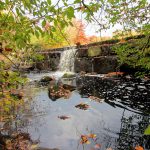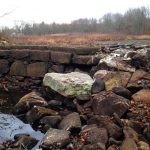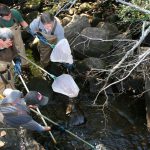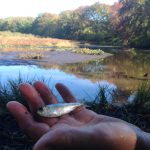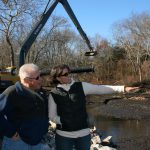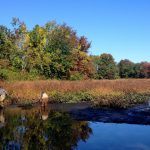[Update: The dam removal is now complete! AND we made an exciting discovery. While Hyde Pond Dam was 150 years old, maps we have found show there may have been a man-made pond there long before. The dam removal has restored natural flow and access for fish for the first time in as much as 350 years!]
Work is well underway to remove an old, deteriorating dam at Hyde Pond in Mystic. Once the natural stream flow and floodplain are re-established, neighbors will be safer from flooding and fish will be able to easily migrate up Whitford Brook for the first time in 150 years.
Keep reading for our joint press release with the U.S. Fish and Wildlife Service, and photos from before and during the project!
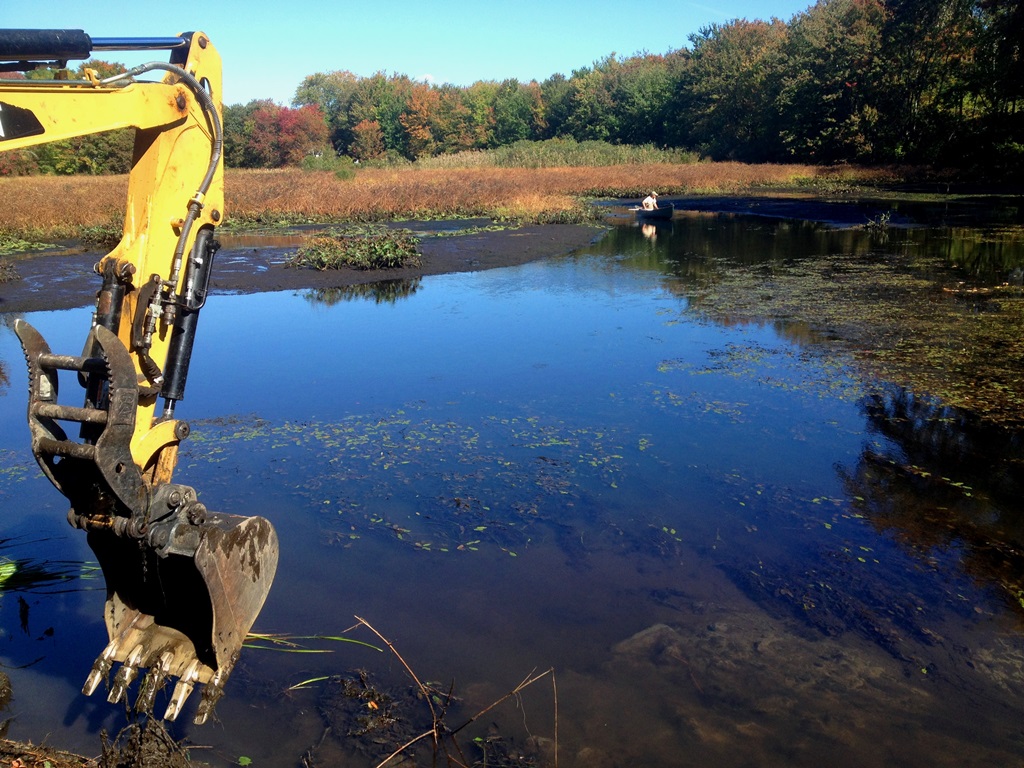
Contact: Laura McMillan (CFE/Save the Sound), lmcmillan@ctenvironment.org; Margie Brenner (USFWS), margie_brenner@fws.gov
Mystic’s Whitford Brook Flows Free for First Time in 150 Years
Dam removal by Save the Sound and US Fish & Wildlife Service underway
Mystic, Conn. – Work has begun to remove Hyde Pond Dam on Whitford Brook, a tributary of the Mystic River. The project, overseen by the U.S. Fish and Wildlife Service and coordinated by Save the Sound, a bi-state program of Connecticut Fund for the Environment, will increase Mystic’s resilience to climate change and storms and will improve wildlife habitat.
The dam removal will eliminate the hazard of potential catastrophic dam failure in the face of future storms. Re-opening natural flow of the brook will restore fish passage to 4.1 stream miles and improve habitat for alewife, blueback herring, and American eel—species that have experienced significant population declines—as well as for other wildlife.
“Dam removals are transformative,” said Gwen Macdonald, habitat restoration director for CFE/Save the Sound. “They restore the river and surrounding landscape, and in the case of Hyde Pond will eliminate the risk of flooding from dam failure in a severe storm. This project reconnects Whitford Brook to its floodplain, which will create a more resilient watershed. Whitford Brook will now support migratory passage for fish species foundational to the Long Island Sound food web.”
“The U.S. Fish and Wildlife Service is delighted to support this important coastal resiliency and habitat restoration project through Hurricane Sandy funds and technical assistance,” said Service fish and wildlife biologist Lori Benoit. “We have partnered with Save the Sound on two dam removals in Connecticut this year. Both projects not only help improve habitat for native fish and wildlife, but they also help protect local communities by reducing the risk of floods from intense storms like Sandy.”
“Removal of the Hyde Pond Dam is a win-win—eliminating a severe flooding risk and restoring and rejuvenating valuable natural habitats. As we face more frequent, severe weather, I applaud efforts by Save the Sound and the U.S. Fish and Wildlife Service to ensure our state’s infrastructure and ecosystems are prepared to withstand the weather we know to expect,” said Senator Richard Blumenthal.
“Removing the Hyde Pond Dam in Mystic will restore more than four miles of river, improving fish populations and the water quality of our rivers and the Long Island Sound,” said Senator Chris Murphy. “But just as important, this project will protect the coastline from future devastation caused by big storms like Hurricane Sandy—a seemingly inevitable consequence of climate change. I’m glad to see more post-Sandy funding heading to Connecticut to make our state a more resilient place to live.”

The project investment is funded through the Disaster Relief Appropriations Act of 2013, which provided the Service with nearly $102 million in federal emergency funding for Hurricane Sandy recovery to strengthen natural defenses that can help protect Atlantic Coast communities against future storms. The Long Island Sound Futures Fund (LISFF) provided an additional $150,000. LISFF is managed by the National Fish and Wildlife Foundation, partnering with the U.S. Environmental Protection Agency, Long Island Sound Study, U.S. Fish and Wildlife Service, and Long Island Sound Funders Collaborative. The program awards grants to conservation and environmental quality projects in Connecticut and New York focused on protection and restoration of Long Island Sound.
“With intensifying storms battering the state in recent years, shoreline towns are scrambling to protect their land from increasing storm surges,” said U.S. Representative Joe Courtney (CT-2). “This is why projects to restore natural storm defenses like floodplains are necessary for coastal communities on Connecticut’s eastern shore. The Whitford Brook dam removal project takes an important step in improving resiliency on our shoreline, while also restoring marine habitats and wetlands in the region. I am looking forward to seeing the results of this important undertaking by U.S. Fish and Wildlife Service and Save the Sound.”
“Removal of the dam is one component of the restoration project,” said Macdonald. “The construction team will work to restore a stream channel which will be the new home of a free-flowing Whitford Brook.” In the spring, CFE/Save the Sound will work with Grasso Technical High School and other partners to enlist youth volunteers in a volunteer planting event to aid in site restoration.
To read more about the Hyde Pond dam removal, click here. To view photos of Hyde Pond dam prior to removal, click here.
CFE/Save the Sound and USFWS are also partnering on a second dam removal project, currently underway at Pond Lily on the New Haven/Woodbridge border. To learn more about other U.S. Fish and Wildlife Service Hurricane Sandy recovery and resilience projects, visit the Hurricane Sandy Recovery website.
###
The mission of the U.S. Fish and Wildlife Service is working with others to conserve, protect, and enhance fish, wildlife, plants, and their habitats for the continuing benefit of the American people. We are both a leader and trusted partner in fish and wildlife conservation, known for our scientific excellence, stewardship of lands and natural resources, dedicated professionals, and commitment to public service. For more information on our work and the people who make it happen in the Northeast region, visit www.fws.gov/northeast. Connect with our Facebook page, follow our tweets, watch our YouTube Channel and download photos from our Flickr page.
Save the Sound is a bi-state program of Connecticut Fund for the Environment with an established 40-year track record of restoring and protecting the waters and shorelines of the Sound. From our offices in New Haven and Mamaroneck, Save the Sound works for a cleaner, healthier, and more vibrant Long Island Sound where humans and marine life can prosper year-round. Our success is based on scientific knowledge, legal expertise, and thousands of ordinary people teaming up achieve results that benefit our environment for current and future generations. Visit www.savethesound.org for more information.

